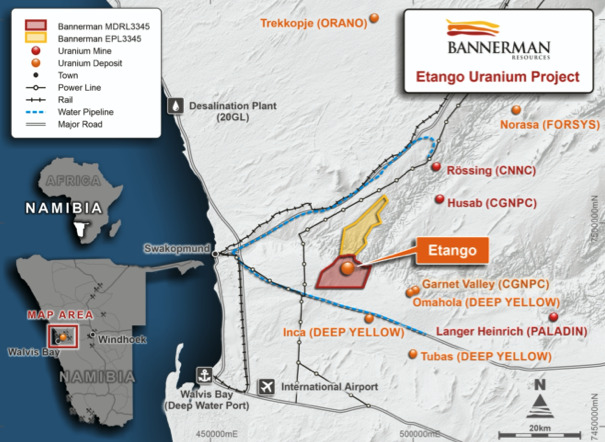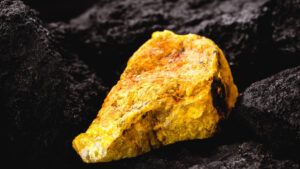Bannerman’s Namibia uranium project poised to capture market upside

Pic: Bloomberg Creative / Bloomberg Creative Photos via Getty Images
- Bannerman Resources reimagines Namibian uranium project to lower costs
- ‘Tremendous growth path for nuclear’ power in current decade, uranium deficit to continue
- ASX uranium stocks guide: Everything you need to know
Uranium company Bannerman Resources (ASX:BMN) has ‘reimagined’ its Etango-8 project in Namibia as a smaller scale mine initially but with the ability to ramp up production as demand improves.
Etango-8 was going to be a 7.2 million pounds of U308 per annum mine under a 2012 definitive feasibility study, but this has been reduced to half of that following a review.
“Etango-8 is a reimagined development of the Etango ore body at a production rate of 3.5 million pounds per annum of U308,” chief executive Brandon Munro said in a presentation on the Virtual Investor Conferences platform.
“At that scale we had significantly reduced development hurdles, dramatically decreased our pre-production capital expenditure, while also decreasing operating expenditure,” he said.
“It enables us to get into production sooner at a more manageable scale, while still preserving the option of increasing our production rate to take advantage of deepening forecast deficits in the uranium market,” Munro said.
Capital and operating costs trimmed for Etango-8
The project’s capital cost has been reduced to $US254m ($357m) and the operating cost to $US37 per pound excluding government royalty payments.
Based on a future market price of $US65 per pound for uranium, Etango-8 has a post-tax net present value of $US212m.
Etango has a total resource of 271 million pounds of U308 in a deposit that is open at depth.
There is a possibility for Bannerman to expand its mine life beyond an initial 14 years, and to expand the project’s production up to 7.2 million pounds per annum.
The Etango-8 project is set to go into production in 2024-2025 following a two-year construction.
The Rössing uranium mine developed by Rio Tinto (ASX:RIO) in Namibia had an initial mine life of 16 years but is still producing after operating for 45 years.
“A few years into production, once we are profitable and have contracts in place and operating successfully, we then make the decision to expand our production up to 7 million pounds per annum as initially contemplated in the DFS,” said Munro.
“We would be making those decisions by 2028 when supply and demand really gaps out,” he said.
Bannerman Resources with a share price of 3.5c has a market cap of only $37m.
This is despite the company spending $US50m ($70m) on its scoping study for Etango-8, including 360,000m of drilling and operating a demonstration processing plant for three years.
“Like much of the sector we have been hit hard by a long bear market,” Munro said, referring to its share price.
“There is a lot of tangible value sitting in that modest market capitalisation,” he said.
Bannerman Resources’ board contains several members with long experience in the uranium business, such as Mike Leech, a former managing director of Rössing when it was the largest uranium mine in the world.

Uranium is emerging from a long bear market
Munro is chairman of the World Nuclear Association’s working group for studying demand and supply scenarios for the uranium market out to 2040 and has deep insight into the market.
Munro also contributes his uranium and nuclear power expertise to the United Nations organisation.
The uranium market starts to go into significant deficit in 2025, and by 2028 the gap between uranium demand and supply starts to widen dramatically, he said in his presentation.
“There is a period of deficit that we are in at the moment, that has been exacerbated by supply disruption caused by COVID-19, but we are in a period of inventory drawdown,” said Munro.
Excess inventory generated since Japan’s Fukushima nuclear plant accident in 2011 has been gradually drawn down, but it will take time before it is completely depleted, he said.
‘Tremendous growth path for nuclear’
Uranium is the ‘unsubstitutable fuel’ for 11 per cent of world electricity generation and supply cannot be easily managed in the sector, as literally the lights will go out.
“The response to a market deficit will be the type of price response we saw in 2005-2007,” said Munro.
Uranium is trading this week at $US30 per pound, after touching a five-year high of $US35/pound in May.
He said he sees a “tremendous growth path for nuclear [power]” stemming from limitations to renewable energy sources and governmental climate change policy.
“The policy shifts that are occurring over the next few years will have their greatest impact from about 2028-2030 onwards,” he said.
There has been a dearth of investment in uranium exploration and mining, and this may be exacerbated as four of the world’s top 10 uranium mines are set to close in the current decade.
Another ASX uranium company, Marenica Energy (ASX:MEY) foresees spot prices for the fuel tripling from current market levels to around $US100/pound in coming years.
Laramide Resources acquires Rio Tinto uranium asset
Meanwhile, ASX uranium company Laramide Resources (ASX:LAM) has completed its acquisition of Rio Tinto Exploration’s Murphy project in the Northern Territory.
Rio Tinto Exploration has received a final payment of $150,000 and 608,520 shares in Laramide Resources issued at a 10 per cent discount to the company’s weighted average share price in the preceding 10 days.
The Murphy tenement covers 683sqkm and is adjacent to Laramide’s Westmoreland project in northwest Queensland, enhancing its landowning in a prospective and underexplored uranium province.
Murphy as a uranium province produced high-grade uranium in the 1950s and has not seen any meaningful exploration since the 1970s.
The Northern Territory is host to the Ranger uranium mine, operated by Energy Resources Australia (ASX:ERA) which is 68 per cent owned by Rio Tinto, that has produced 120,000 tonnes of U308 over a 35-year period.
Laramide Resources has uranium assets in Australia, and the US including its La Jara Mesa project in New Mexico and La Sal project in Utah.
Share prices for Bannerman (ASX:BMN), Laramide (ASX:LAM), Marenica Energy (ASX:MEY)
Related Topics

UNLOCK INSIGHTS
Discover the untold stories of emerging ASX stocks.
Daily news and expert analysis, it's free to subscribe.
By proceeding, you confirm you understand that we handle personal information in accordance with our Privacy Policy.








